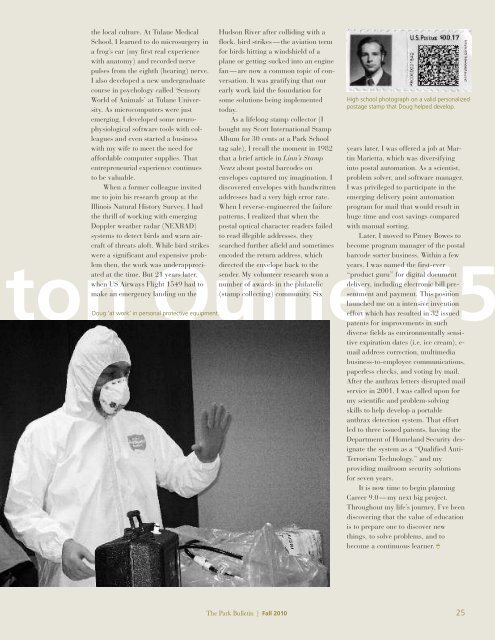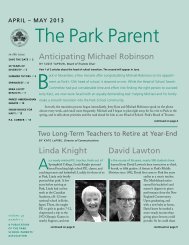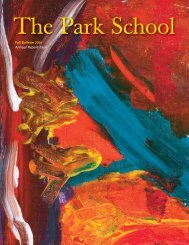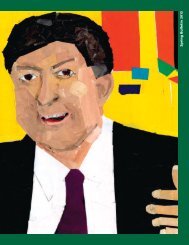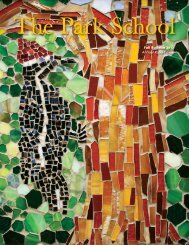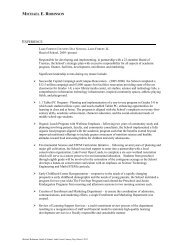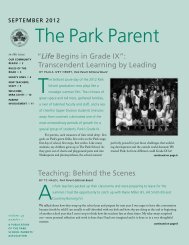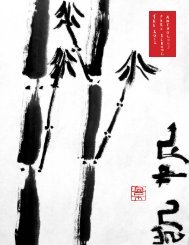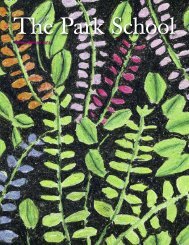A L U M N I S C I E N T I S T :DOUGLAS BOYNTON QUINE ’65Doug started at <strong>Park</strong> in the middle of Grade II when hisfamily moved to Boston, but he spent third grade inCalifornia where his philosopher father, Professor W.V.Quine, was at Stanford while on sabbatical from Harvard.When the Quines returned to Boston the followingyear, Doug attended <strong>Park</strong> for four years, graduatingwith his Grade VIII class*. After half a year of travel inEurope and a semester at Middletown High <strong>School</strong> inConnecticut, he graduated from Roxbury Latin <strong>School</strong>.At Princeton, Doug studied biology, then worked at<strong>The</strong> Rockefeller University as an acoustical consultantouglas BoynIbefore going to Cornell University to earn a PhD inneurobiology and behavior in 1979. In 2008, to parallela series of international conferences recognizing thecentennial of his father’s birth, Doug co-edited twobooks (with Harvard University Press) of his father’sout–of-print papers and unpublished work from thefamily archives. Early this year, after a 22-year career inengineering postal systems, Doug took early retirementfrom Pitney Bowes. Having lived in Nova Scotia, NewOrleans, Illinois, Florida, Virginia, and Albuquerque,Doug and his wife, Maryclaire, returned to their NewEngland roots, settling in Bethel, Connecticut, in 1993.Doug and Maryclaire enjoy traveling immensely; theyhave visited all 50 states, and this summer’s trip toGibraltar makes 52 countries. <strong>The</strong>ir children, Alexander(Oberlin ’07) and Victoria (Hampshire ’10), have beguntheir independent lives.* Over <strong>Park</strong>’s 122-year history, the number of grades offered and thegraduation year have varied. For many years, Grade VIII was the yearof graduation; others graduated when VI or VII was <strong>Park</strong>’s final year.Also, it was never unusual for some students to leave <strong>Park</strong> beforethe year of graduation. During the last 43 years, <strong>Park</strong> has offered aGrade IX program as the final year. <strong>The</strong> <strong>School</strong> therefore assigns to itsalumni a class year based on the Grade IX year.<strong>The</strong> Thrill of Innovation and Researchenjoy understanding how existingthings work and inventingnew things. As a child I readvoraciously and pestered everyonefrom winemakers to telephonerepairmen for details ofwhat they were doing and why. Mycuriosity and love of independentlearning continues to this day.At <strong>The</strong> <strong>Park</strong> <strong>School</strong>, Mr. Meadowsintroduced me to the study of science,the experimental method, and the ideaof bringing order and sense to randomassortments of facts. Since then, mypassion has been to explore emergingtopics. Through my high schoolresearch project at Massachusetts Eyeand Ear Infirmary (polarized lightinducedHaidinger Brush illusion),summer work at Fruitlands Museumsin Harvard, and my independent studyprogram at Roxbury Latin <strong>School</strong>(heart surgery and artificial heartvalves at Massachusetts General Hospital),I discovered the thrill ofDoug with the Honda Civic hybrid purchased with his32 patent awards.<strong>The</strong> value of education is to prepare oneto discover new things, to solve problems,and to become a continuous learner.research and independent study. AtPrinceton, research for my undergraduatethesis revealed the ability of barnowls to detect shifts in sound pitch(which might help them find prey)and resulted in my first refereed scientificjournal article in the Journal ofComparative Physiology. As anacoustical consultant at <strong>The</strong> RockefellerUniversity, I measured the environmentalacoustics of naturalenvironments in Maine, New York, andPanama, helping to explain differencesin animal vocalizations in differenthabitats. My doctoral research at Cornellin animal behavior required developingnew equipment to uncover thehoming pigeons’ ability to hear 10octaves below human hearing. (Suchinfrasounds can travel very long distancesand might have value as navigationalcues.) My postdoctoralresearch on hearing changes in multiplesclerosis revealed unexpected pitch(frequency) and loudness (amplitude)channels in hearing system.Following my postdoc in Halifax,we moved to New Orleans and enjoyed24 <strong>The</strong> <strong>Park</strong> Bulletin | Fall 2010
the local culture. At Tulane Medical<strong>School</strong>, I learned to do microsurgery ina frog’s ear (my first real experiencewith anatomy) and recorded nervepulses from the eighth (hearing) nerve.I also developed a new undergraduatecourse in psychology called ‘SensoryWorld of Animals’ at Tulane University.As microcomputers were justemerging, I developed some neurophysiologicalsoftware tools with colleaguesand even started a businesswith my wife to meet the need foraffordable computer supplies. Thatentrepreneurial experience continuesto be valuable.When a former colleague invitedme to join his research group at theIllinois Natural History Survey, I hadthe thrill of working with emergingDoppler weather radar (NEXRAD)systems to detect birds and warn aircraftof threats aloft. While bird strikeswere a significant and expensive problemthen, the work was underappreciatedat the time. But 21 years later,when US Airways Flight 1549 had tomake an emergency landing on theyears later, I was offered a job at MartinMarietta, which was diversifyinginto postal automation. As a scientist,problem solver, and software manager,I was privileged to participate in theemerging delivery point automationprogram for mail that would result inhuge time and cost savings comparedwith manual sorting.Later, I moved to Pitney Bowes tobecome program manager of the postalbarcode sorter business. Within a fewyears, I was named the first-ever“product guru” for digital documentdelivery, including electronic bill presentmentand payment. This positionlaunched me on a intensive inventioneffort which has resulted in 32 issuedton Quine ’65patents for improvements in suchDoug ‘at work’ in personal protective equipment.Hudson River after colliding with aflock, bird strikes —the aviation termfor birds hitting a windshield of aplane or getting sucked into an enginefan—are now a common topic of conversation.It was gratifying that ourearly work laid the foundation forsome solutions being implementedtoday.As a lifelong stamp collector (Ibought my Scott International StampAlbum for 30 cents at a <strong>Park</strong> <strong>School</strong>tag sale), I recall the moment in 1982that a brief article in Linn’s StampNews about postal barcodes onenvelopes captured my imagination. Idiscovered envelopes with handwrittenaddresses had a very high error rate.When I reverse-engineered the failurepatterns, I realized that when thepostal optical character readers failedto read illegible addresses, theysearched further afield and sometimesencoded the return address, whichdirected the envelope back to thesender. My volunteer research won anumber of awards in the philatelic(stamp collecting) community. SixHigh school photograph on a valid personalizedpostage stamp that Doug helped develop.diverse fields as environmentally sensitiveexpiration dates (i.e. ice cream), e-mail address correction, multimediabusiness-to-employee communications,paperless checks, and voting by mail.After the anthrax letters disrupted mailservice in 2001, I was called upon formy scientific and problem-solvingskills to help develop a portableanthrax detection system. That effortled to three issued patents, having theDepartment of Homeland Security designatethe system as a “Qualified Anti-Terrorism Technology,” and myproviding mailroom security solutionsfor seven years.It is now time to begin planningCareer 9.0—my next big project.Throughout my life’s journey, I’ve beendiscovering that the value of educationis to prepare one to discover newthings, to solve problems, and tobecome a continuous learner.<strong>The</strong> <strong>Park</strong> Bulletin | Fall 2010 25


